|
The fine sieve of
memory: What actually happened and what became the accepted, somewhat
final version of that occurrence are trailed by hesitant gaps in memories
and warps of shadowy, embroidered experience. Today South Asians, often
in the suburbs of America's art world, are mixing in various media,
others' reminiscences with their own dreams and histories. Indians think
fondly of a time when Bharat (or Hindustan) was one. Political borders
come and go and people, in succession, learn to consider themselves:
Bharatiya, then Hindustani, then Pakistani, then Bangladeshi and today
American, Trinidadian, or Kenyan. Boundaries shift but recollections
of ancient inheritances, colonial occupation and modern prejudice remain.
In America and Britain, Indians have reached out to fellow South Asians,
those who used to be 'apna' (ours), and asked to see their art.
Reaching across
today's political boundaries, the Indo-American Arts Council's indefatigable
Aroon Shivdasani has launched her annual exhibition, 'Erasing Borders'.
Aroon comes from Sindh, a part of India which went to Pakistan. However
from Sindh also came Sindhbad's stories and here we see artists and
inheritors of these lands crossing political limitations and religion,
erasing border histories, and converging on common beloved experiences
to tell us travelers' tales. This migration carries stories of what
used to be and of partition, divorced borders, marriages across faiths,
across class. They originate from lands overwhelmed with art and hence
it was just a blip of time before this brimming energy exploded across
canvas, clay and film. These artworks of the diaspora, some simple,
some highly accomplished, were chosen with one criterion: Do they erase
borders between India, Pakistan, Sri Lanka…?
Laughter, irony,
mockery and anguish are there, especially after 9/11, after Iraq, after
racial profiling. Youngsters who had basked in the suburban wealth created
by their adventurous parents, now knew they were not simply American
but brown and Asian. Race, color, religion had again become major parameters
to measure humankind. How did they see their world and how would they
depict it? 'Erasing Borders' provides some doorways, some glimpses.
While somewhat unrelated Sanskrit or Islamic symbols do lurk, the show
represents now: people who belong together, who officials term 'South
Asian', a term unknown in the Indian subcontinent.
And so Siona Benjamin,
Indian Bene Israeli, draws fine pictures of Leah and Rachel with Krishna's
luminous dark blue skin. Coming from the only Jews in the world who
have always known safety, Siona said her childhood was never discolored
with prejudice or ripped by Europe's bloody Holocaust. The Indian Benes
were free, never 'the other', never accused of killing a reincarnated
middle-eastern deity. These are her worlds of similarities, 'Tikkun'
she reiterates, detailed like miniatures but with the spare spaces and
emptiness of modern experiences.

Finding Home # 8
"Rachel and Leah" |

Root I |
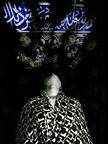
Night Journey |

Kathak Dancers |
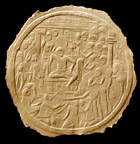
Ajanta Cave Panel -
fingernail relief drawing |
There is a smoke
and light filled picture of Kathak dancers by New Yorker Veru Narula.
Kathak was danced while worshiping Krishna but later was truly loved
by Muslim rulers. Here dancers in gorgeous, bright tradition continue
undaunted amidst poisonous fumes from an explosion in a temple. They
continue dancing but wear gas masks.
Amina Ahmed, 'Root
#1' shows a long hank of hair, heavy with tales of social attitudes.
Long hair is admired and both Islam and Sikhism have so many standards
defining who should cover their hair, to what degree, how it should
be grown, who must sport it on faces and who must remove it. Wispy tangles
of hair, religions, regions....
Indian galleries
in America are businesses that often emphasize established artists popular
with rich doctors and lawyers. Here, these new artists located in Los
Angeles, Chicago or Houston, are free to remember countries and times
they never knew except through sighs and stories in languages they do
not really speak. They glance out of their windows and see Brooklyn
or Devon Street and so we see depictions of Hindi movies, mangos, miniatures,
Urdu fonts, Hebrew words, a garam masala of worlds.
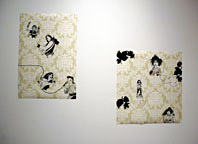
Karma Chameleon |
|
Fariba Alam's striking
'The Night Journey', with its dark, poignant and mysterious tiles, speaks
of lovely old mosques and shows females without faces looking up at
Urdu fonts. However Bangladeshi women were often feisty feminists who
made sure that society respected them! Shelly Bahl's 'Karma Chameleon',
plays on Boy George's song and shows the fine art of drawing with playful
karaoke-like images and manga figures with lucid, beautifully delineated
expressions. Anna Indumati Bhushan's 'Untitled' is figurative with delicate
precise details in paint and fine dot work of 'personal tales from non-personal
themes'.
The torn, scattered
maps in Bushra Chaudry's, ' Broken Borders VIII', speak of unspeakable
politics, of grief and loss and the ever present, imminent possibility
of the demolition of this world. Suhas Tavkar's craft shows a rare relationship
between the human form and the human touch that created it. He uses
his nails on card paper to create slow, painful art that permits no
mistake, there is no going back. For Indians, the Golden Age is the
Gupta period and here he recreates it. In 'Everything in between,' Niema
S. Khan-Qureshi shows the mirrors of dangling memory and pinching pictures,
filled with dadis, didis, (relatives), and babies.
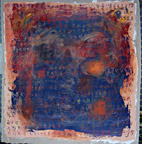 Sujata
Sujata |

Untitled-1 |

Broken Borders -VIII |
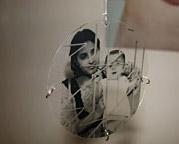
Everything in Between |
| |

For Regret |
| |
|
| |
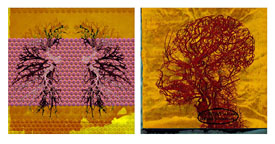 Fashion
Accessories: To Stop Smoking
Fashion
Accessories: To Stop Smoking |
Prince Varughese
Thomas incorporates photography and digital techniques in 'Fashion Accessories'.
Born in Kuwait, he grew up in India and in the United States. This crisscrossing
of politics, physical premises and psychological borders is now his
mother lode. His 'For Regret' is grey and black with an old Indian fort
and floating red balloons. What does he regret? A secure history, rosy,
floating hopes? Reuben Sinha's 'Sujata' is speckled with symbols and
alphabets. He remembers writing Hindi as a child and the fascinating
fonts on billboards and in his mother's letters to his father. Now he
creates font-like symbols without formal meanings. He incorporates etching
and draws figures, after delving into the mysteries and power of Tantric
art. 'Tantra' is vibration and, for Indians, all matter at its very
core consists of vibrating energy.
The teacher and
printmaker, Vijay Kumar, curated this exhibition with its silvery breathing
ball, temple dancers, dusty manuscripts, one Alice in Wonderland (or
is it two?), yantra pathways, jute bags in which refugees carried a
life, politics and depictions of god's many arms, names and hijabs.
Erasing Borders
2008: Passport to Contemporary Indian Art of the Diaspora will travel
until Oct 2008. Amina Ahmed is the Director of this Exhibition.
|











